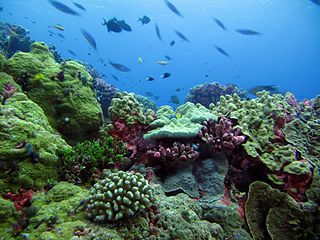
Protected areas or conservation areas are locations which receive protection because of their recognized natural, ecological or cultural values. Protected areas are those areas in which human presence or the exploitation of natural resources is limited.

The International Union for Conservation of Nature (IUCN) is an international organization working in the field of nature conservation and sustainable use of natural resources. Founded in 1948, IUCN has become the global authority on the status of the natural world and the measures needed to safeguard it. It is involved in data gathering and analysis, research, field projects, advocacy, and education. IUCN's mission is to "influence, encourage and assist societies throughout the world to conserve nature and to ensure that any use of natural resources is equitable and ecologically sustainable".

Marine protected areas (MPA) are protected areas of the world's seas, oceans, estuaries or in the US, the Great Lakes. These marine areas can come in many forms ranging from wildlife refuges to research facilities. MPAs restrict human activity for a conservation purpose, typically to protect natural or cultural resources. Such marine resources are protected by local, state, territorial, native, regional, national, or international authorities and differ substantially among and between nations. This variation includes different limitations on development, fishing practices, fishing seasons and catch limits, moorings and bans on removing or disrupting marine life. In some situations, MPAs also provide revenue for countries, potentially equal to the income that they would have if they were to grant companies permissions to fish. The value of MPA to mobile species is unknown.

Marine conservation, also known as ocean conservation, is the protection and preservation of ecosystems in oceans and seas through planned management in order to prevent the over-exploitation of these marine resources. Marine conservation is informed by the study of marine plants and animal resources and ecosystem functions and is driven by response to the manifested negative effects seen in the environment such as species loss, habitat degradation and changes in ecosystem functions and focuses on limiting human-caused damage to marine ecosystems, restoring damaged marine ecosystems, and preserving vulnerable species and ecosystems of the marine life. Marine conservation is a relatively new discipline which has developed as a response to biological issues such as extinction and marine habitats change.

Marine conservation activism is the efforts of non-governmental organizations and individuals to bring about social and political change in the area of marine conservation. Marine conservation is properly conceived as a set of management strategies for the protection and preservation of ecosystems in oceans and seas. Activists raise public awareness and support for conservation, while pushing governments and corporations to practice sound ocean management, create conservation policy, and enforce existing laws and policy through effective regulation. There are many different kinds of organizations and agencies that work toward these common goals. They all are a part of the growing movement that is ocean conservation. These organizations fight for many causes including stopping pollution, overfishing, whaling and by-catching, and supporting marine protected areas.

The World Commission on Protected Areas (WCPA) is one of six commissions of the International Union for Conservation of Nature (IUCN).
A Marine Protected Area Network or MPA network is a network of Marine Protected Areas or Marine Reserves.

Abashiri Quasi-National Park is a quasi-national park in Japan. The park protects the waters and surrounding coastline of the lakes and lagoons along the Sea of Okhotsk on Hokkaidō. This includes such lakes as Lake Abashiri and Lake Notoro as well as Lake Tōfutsu and Lake Saroma. Lake Saroma is the fourth largest lake in Japan. Most of the park lies within the limits of Abashiri in Abashiri Subprefecture of northeastern Hokkaidō.
Niseko-Shakotan-Otaru Kaigan Quasi-National Park is a quasi-national park in the Shiribeshi Subprefecture of Hokkaido, Japan. On the coast of the Sea of Japan, there is a Marine Protected Area covering the west and north coast of Shakotan peninsula from Kamoenai to Otaru. The park also protects the area around the Mount Raiden and Niseko Volcanic Groups. Niseko-Shakotan-Otaru Kaigan Quasi-National Park was established in 1963.

The World Database on Protected Areas (WDPA) is the largest assembly of data on the world's terrestrial and marine protected areas, containing more than 260,000 protected areas as of August 2020, with records covering 245 countries and territories throughout the world. The WDPA is a joint venture between the United Nations Environment Programme World Conservation Monitoring Centre and the International Union for Conservation of Nature World Commission on Protected Areas.
Tundi Agardy is a marine conservationist and the founder of Sound Seas – a Washington DC-based group specializing in working at the nexus of marine science and policy in order to safeguard ocean life.

Giuseppe Notarbartolo di Sciara is an Italian marine conservation ecologist who has bridged the worlds of marine science, conservation and policy.
Erich Hoyt is a whale and dolphin (cetacean) researcher, conservationist, lecturer and author of 26 books and more than 700 reports, articles and papers. His book Marine Protected Areas for Whales, Dolphins and Porpoises, has been widely reviewed as the "definitive reference of the current extent of cetacean ecosystems-based management" and as "a unique and essential book for anybody interested in the conservation and protection of cetaceans. [This] definitive source on MPAs marine protected areas for cetaceans…will influence the design and management of this important and rapidly developing conservation tool." Choice listed the book as an "Outstanding Academic Title’ for the year 2012. Since 2013, as Research Fellow with Whale and Dolphin Conservation (WDC) and IUCN SSC/WCPA Marine Mammal Protected Areas Task Force co-chair with Giuseppe Notarbartolo di Sciara, Hoyt has focussed on the creation and development of the new conservation tool of Important Marine Mammal Areas, or IMMAs. In 2016, following a MAVA Foundation pilot project to identify IMMAs in the Mediterranean, the Task Force's GOBI collaboration funded by the German Climate Initiative (IKI) began a six-year project to identify and implement IMMAs across most of the southern hemisphere. The IMMA tool has been received and widely endorsed by the Convention on Migratory Species (CMS), the Convention on Biological Diversity (CBD), various commissions within the International Union for Conservation of Nature (IUCN), the International Whaling Commission, as well as national governments and scientists.
Marine Conservation Institute is a tax-exempt nonprofit ocean conservation organization working to identify and protect vulnerable ocean ecosystems worldwide. The organization is headquartered in Seattle, Washington, with offices in Washington, D.C., and Glen Ellen, California.
Penelope Figgis is an Australian environmentalist, activist, and political scientist. Since 2005 she has been the Vice Chair for Oceania of the IUCN World Commission on Protected Areas.
Kristina Maria Gjerde is a High Seas Policy Advisor for the International Union for Conservation of Nature Global Marine and Polar Program. She works on the Global Ocean Biodiversity Initiative and won the 2018 Boat International Visionary Ocean Award.
The marine protected areas of South Africa are in an area of coastline or ocean within the exclusive economic zone (EEZ) of the Republic of South Africa that is protected in terms of specific legislation for the benefit of the environment and the people who live in and use it. An MPA is a place where marine life can thrive under less pressure than unprotected areas. They are like underwater parks, and this healthy environment can benefit neighbouring areas.
The Prince Edward Island Marine Protected Area is an offshore conservation region near the Prince Edward Islands in the exclusive economic zone of South Africa, nearly 2,000 km southeast of South Africa in the Indian Ocean. The MPA provides habitat for seals, killer whales, breeding seabirds and Patagonian toothfish.

Important Marine Mammal Areas (IMMAs) were formulated by the joint International Union for Conservation of Nature (IUCN) Species Survival Commission / World Commission on Protected Areas, Marine Mammal Protected Areas Task Force (MMPATF)
The Mediterranean Protected Areas Network (MedPAN) is one of the main non-governmental organizations dedicated to the protection of nature in the Mediterranean.









